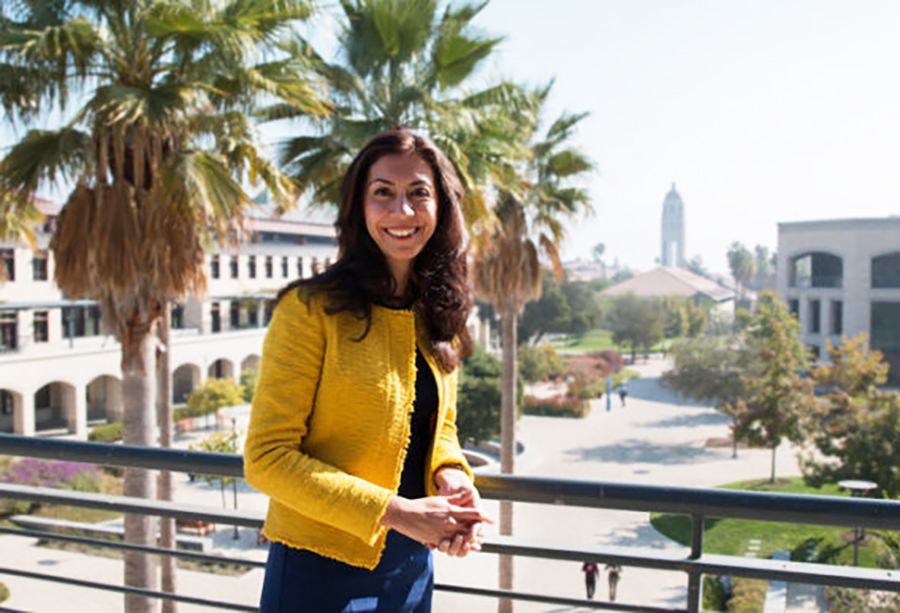
Newsha Ajami. Photo courtesy Stanford University.
As a little girl in Iran, Stanford water researcher Newsha Ajami always knew she could achieve whatever she wanted. “I was raised as a gender-blind child,” she recalled. “I was taught that I could beat anybody at anything.” Her love of math, boundless curiosity, and passion to make a difference have taken her far beyond what she ever imagined while growing up.
Today, Ajami lives in the Bay Area and is dedicated to safeguarding our water. Her roles include directing the Urban Water Policy team at Stanford’s Water in the West program and serving on the San Francisco Bay Regional Water Quality Control Board. But she began her career in civil engineering at Tehran Polytechnic in 1993, where most of her studies were on the structural side. “I got into the world of water quite accidentally,” she said. “I was looking for an internship and got one focusing on reservoir management.” She’s been hooked on the ins and outs of delivering water to people ever since.
Back then, she was particularly drawn to the twin challenges of using engineering to manage water scarcity, and of managing rivers and other waterways. These interests led her to the University of Arizona in Tucson in the year 2000, where she earned a master’s degree in hydrology — the science of how water is distributed and moves in nature — and water management. There, she worked on forecasting the water supply.
“I wanted to understand how accurate we are at estimating hydrological processes,” Ajami said, explaining that inaccuracies can put users like farmers in a bind. “If you’re uncertain about the amount of rain or snow you’re going to get, farmers will be uncertain about how much they can use.” She continued her forecasting work at UC Irvine beginning in 2003, ultimately earning a Ph.D. in civil and environmental engineering.
Then Ajami’s trajectory took another surprising turn, sparked by a class she’d taken at the University of Arizona on water policy. “I was just fascinated with all the laws that go into management and that sometimes don’t make a lot of sense,” she said. “It was wild from an engineer’s perspective — it’s not necessarily logical.” For example, instead of allocating water equally amongst users, we divvy it up according to when the land was settled. People on lands that were settled first have seniority when it comes to water rights.
In 2010, Ajami delved into her interest in policy as a Science and Technology fellow at the California State Senate’s Natural Resources and Water Committee. The legislature was another new world for Ajami. “It’s all about relationships and priorities at a given time,” she said. “There’s nothing rational you can model, it’s very different from math.”
The experience transformed her work. “It was one of the defining moments of my life,” Ajami said. “If you want to make an impact, you have to inform decision-making — I came out of the fellowship truly inspired.”
Since then, Ajami has channeled that inspiration into identifying ways to boost water conservation. At Stanford’s Water in the West program, she leads research on innovative — that is, non-traditional — financing that encourages users to consume less water. One example is to set up formal trading mechanisms, allowing people who conserve water to sell their unused portion. “The goal is to enable water use reduction, which leaves more in the system for others,” she explained.
The idea sprang from her fellowship with the state legislature. “We worked on innovative financing in energy and climate change,” Ajami said. “I thought, why don’t we do this in the water sector?” Her work was at the forefront of this movement and has informed policy. Notably, she analyzed an effort to establish a public goods charge — a small fee in utility bills that funds related public-interest programs — in the energy sector. “I looked at lessons learned and pitfalls to learn how to implement it successfully in the water sector,” she explained. “It ended up getting picked up by the legislature,” she said, referring to a presentation of her findings that she made to the California State Senate’s Natural Resources and Water Committee in 2016.
Ajami also wants to use data on water use to change the way we approach water conservation as a society. “In resource consumption, people are always looked at just as consumers, not as participants,” she said. “I want to understand the human role — what people do and how they think — and include it in engineering estimates. We’re trying to use big data to better understand how human behavior impacts water.”
Putting people in the equation can help water managers make better decisions. For example, Ajami’s team used data from smart meters to track patterns of landscape irrigation by businesses and multi-family homes during our recent extreme drought. Some irrigated with drinking water and so were limited by state conservation mandates, while others irrigated with recycled water and so had no restrictions on use. But it turned out that both groups conserved. “You need to focus on demand, not just supply all the time,” Ajami says. “Even those using recycled water cut back, so providing that supply was not a good investment.”
Ajami became even more involved with water policy in 2013, when then-governor Jerry Brown appointed her to the San Francisco Bay Regional Water Quality Control Board. This experience has deepened her insights into our water supply even further. “Before, I thought water conservation and efficiency were the most important,” she said. “Today I think resource protection is the most important. If you don’t protect the quality, you don’t have [usable] water — I never realized how fundamental water quality is until then.”
For all the challenges we face in protecting the quantity and quality of our water supply, Ajami is an optimist: “I think we can definitely work through them all.” That said, she cautions that it will take more than technological fixes. “Technology is very important but I don’t think it’s going to be a silver bullet,” she said. “Water is a limited resource, and it’s all about public awareness and knowledge to make people part of the solution, rather than only the consumer of what we’re giving them.”
Many people don’t think about water because it’s cheap, available, and never runs out, she explained. But a study she led during the recent drought linked news coverage with water conservation even before the governor imposed mandatory restrictions. “If people know, they do respond,” she said.
Robin Meadows covers water for the Monitor.

